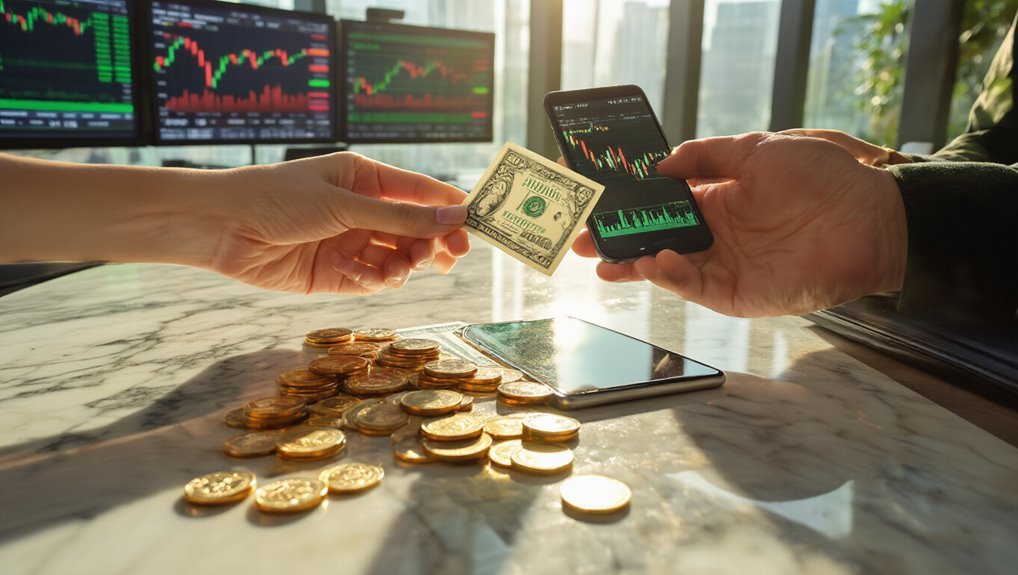Spot trading enables investors to buy or sell financial assets at current market prices with immediate delivery. Settlement occurs instantly or within two business days, reflecting real-time supply and demand. Unlike futures contracts, spot trading provides direct ownership without expiration dates or leverage complexity.
Orders execute through brokers or platforms using various methods including market, limit, and stop orders. This transparent approach offers lower fees and immediate control over actual assets. The fundamentals reveal deeper strategic advantages.
Fundamentals of Spot Trading

While many traders get caught up in complex derivatives and future contracts, spot trading strips away the complications and gets straight to the point. This approach involves buying or selling financial assets at their current market price for immediate delivery. Simple. Direct. No waiting around.
Spot trading cuts through the noise – buy or sell at current market price with immediate delivery and zero complications.
The spot price reflects real-time supply and demand. What you see is what you get. Settlement happens instantly or within two business days maximum. There’s no contract specifying future delivery dates like you’d find with futures trading.
Spot markets cover everything. Currencies, commodities, stocks, cryptocurrencies. The price updates continuously based on live trading activity. This makes spot prices the most transparent indicator of an asset’s immediate value. The spread difference between bid and ask prices provides insight into market liquidity and trading costs.
Unlike derivative markets that trade on expectations, spot trading deals with current reality. The market dynamics are straightforward – buyers and sellers meet at the current price point. No speculation about future conditions required. The immediate settlement feature allows traders to quickly adapt to market changes. Spot trading offers a beginner-friendly approach that makes it particularly accessible for those new to financial markets.
How Spot Markets Operate and Execute Transactions
Every spot trade follows the same basic path from order to settlement. Traders submit orders through brokers or platforms, specifying security details and order types. Brokers then route these orders to ideal venues—exchanges, market makers, or internal pools.
The execution process varies by order type:
| Order Type | Execution Method |
|---|---|
| Market Orders | Execute immediately at current price |
| Limit Orders | Execute only at specified price or better |
| Stop Orders | Convert to market orders when triggered |
| Algorithmic Orders | Automated execution based on predefined criteria |
| Manual Orders | Human-directed placement and timing |
Speed matters. Markets move fast, and delays cause slippage. Automated systems increasingly dominate, analyzing real-time data to enhance timing and pricing. Advanced algorithms can continuously monitor market conditions and optimize performance parameters to maintain competitive advantages in rapidly changing environments.
After execution, confirmation details reach traders immediately. Settlement follows T+2 schedule—ownership transfers within two business days. Trading platforms implement security services to protect against malicious attacks that could disrupt these critical transaction processes. This “immediate delivery” distinguishes spot markets from futures contracts, emphasizing prompt asset transfer over delayed obligations. Price variations in spot trades are influenced by interest rates and the duration until settlement, affecting the final transaction value.
Key Benefits and Practical Applications
Understanding how spot markets function sets the stage for recognizing why traders gravitate toward this straightforward approach.
Spot trading delivers immediate ownership. Actual assets. Real control. This matters for long-term investors seeking growth or dividend income. Companies needing physical commodities can lock in current prices. Smart hedging without complex contracts.
Settlement happens instantly. No waiting. No uncertainty about future prices. This eliminates exposure to adverse price swings that plague futures contracts. Traders avoid rollover fees and contract management headaches.
Flexibility stands out. No fixed contract sizes or expiration dates. Buy any quantity – fractional shares, whole commodities, partial cryptocurrencies. Capital requirements scale with investor capacity.
Cost efficiency runs deep. Lower fees than futures trading. High liquidity enables rapid order execution. Transparent pricing reflects real supply and demand. Transactions operate effectively across both organized exchanges and over-the-counter platforms.
Applications span conservative buy-and-hold strategies to aggressive day trading. Companies hedge commodity risks. Individual investors gain market exposure without leverage complications. Portfolio diversification becomes straightforward through direct asset ownership. Traders execute at current market prices without complicated contract structures or timing restrictions. Exchanges use price and time priority to match orders systematically.
Spot Trading vs. Futures and Derivatives Markets

Traders face a fundamental choice between spot markets and derivatives. The differences are stark.
Spot trading means immediate ownership. You buy Bitcoin, you own Bitcoin instantly. Futures contracts? Different story. You’re buying agreements for future delivery, not the actual asset.
Price discovery works differently too. Spot prices reflect current market conditions. Right now. Futures prices bake in expectations, interest rates, and time value. They can diverge considerably from spot prices.
Spot prices tell you what’s happening now. Futures prices tell you what traders think will happen.
Risk profiles vary dramatically. Spot trading limits your risk to what you actually invested. No leverage, no margin calls. Futures amplify everything through leverage. Bigger gains, bigger losses, bigger headaches.
Settlement tells the whole story. Spot markets settle within days. Futures wait until contract expiration or position closure.
Liquidity favors spot markets, especially in major assets. More depth, easier entry and exit. Futures markets depend on contract specifications and trader interest. Major exchanges operate around the clock with continuous trading opportunities. Spot markets require full capital upfront for each transaction. Spot markets provide market depth that facilitates smoother trading execution.
Choose based on your goals and risk tolerance.
Frequently Asked Questions
What Are the Typical Fees and Costs Associated With Spot Trading?
Spot trading fees typically hover around 0.1% per trade for both makers and takers across major exchanges like Binance and Bitget. Platform tokens can slash fees by 20-25%. High-volume traders enjoy significant discounts—some pay as little as 0.0050% maker fees through VIP tiers. Additional costs include withdrawal fees, network transaction costs, and implicit spread expenses. Trading volume and token holdings directly impact final fee percentages.
How Do Taxes Apply to Gains and Losses From Spot Trading?
Spot trading generates taxable events whenever crypto gets sold, traded, or spent. Short-term gains under one year face ordinary income tax rates. Long-term gains over one year qualify for lower capital gains rates of 0%, 15%, or 20%. Trading fees increase cost basis, reducing taxable gains. Capital losses offset gains and up to $3,000 of other income annually. Traders must track each transaction separately.
What Are the Minimum Investment Amounts Required for Different Spot Markets?
Most spot markets allow remarkably low entry points. Crypto exchanges like Binance accept $100 minimums, with order sizes as small as 1 USDT or 0.000005 BTC. Stock platforms often require similar amounts – sometimes less with fractional shares. Deposit minimums range from $0 to several hundred dollars depending on the broker. Exchange policies, asset prices, and regulatory requirements ultimately determine these thresholds. Beginners should start small to learn mechanics.
Which Brokers or Platforms Are Best for Beginners in Spot Trading?
For crypto spot trading, beginners should consider Fusion Markets and FP Markets. Both offer low barriers to entry, demo accounts, and copy trading features. Stock traders fare well with Charles Schwab’s $5 fractional shares and extensive education resources. Firstrade and Merrill Edge provide zero-commission trading with research tools. International traders might explore OceanOne for fewer restrictions. These platforms prioritize user-friendly interfaces and educational support for novices.
How Can I Manage Risk When Starting Spot Trading With Limited Experience?
New traders should start small with position sizing—never risk more than 2-5% of total capital per trade. Set stop-loss orders immediately to cap losses automatically. Diversify across multiple cryptocurrencies rather than betting everything on one coin. Study market fundamentals and technical analysis continuously. Most importantly, control emotions. Fear and greed kill accounts faster than market volatility. Stick to predetermined strategies regardless of short-term price swings.



